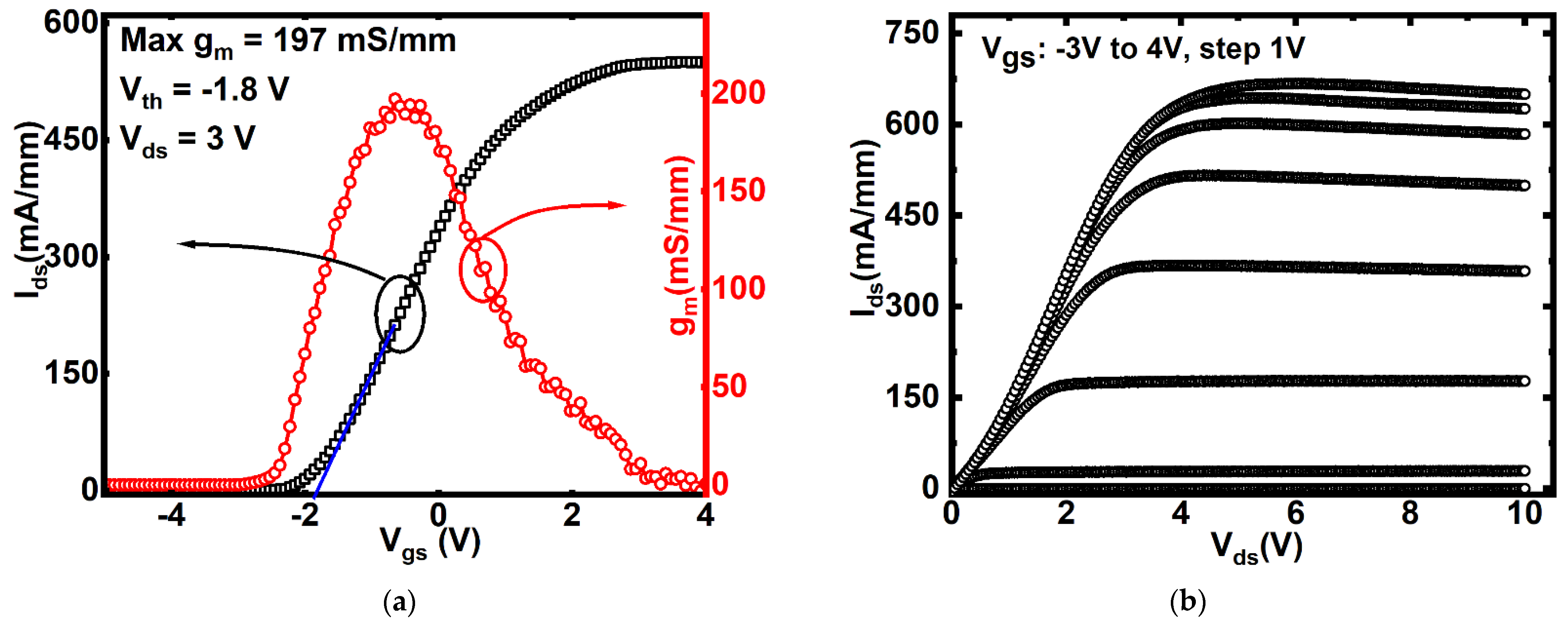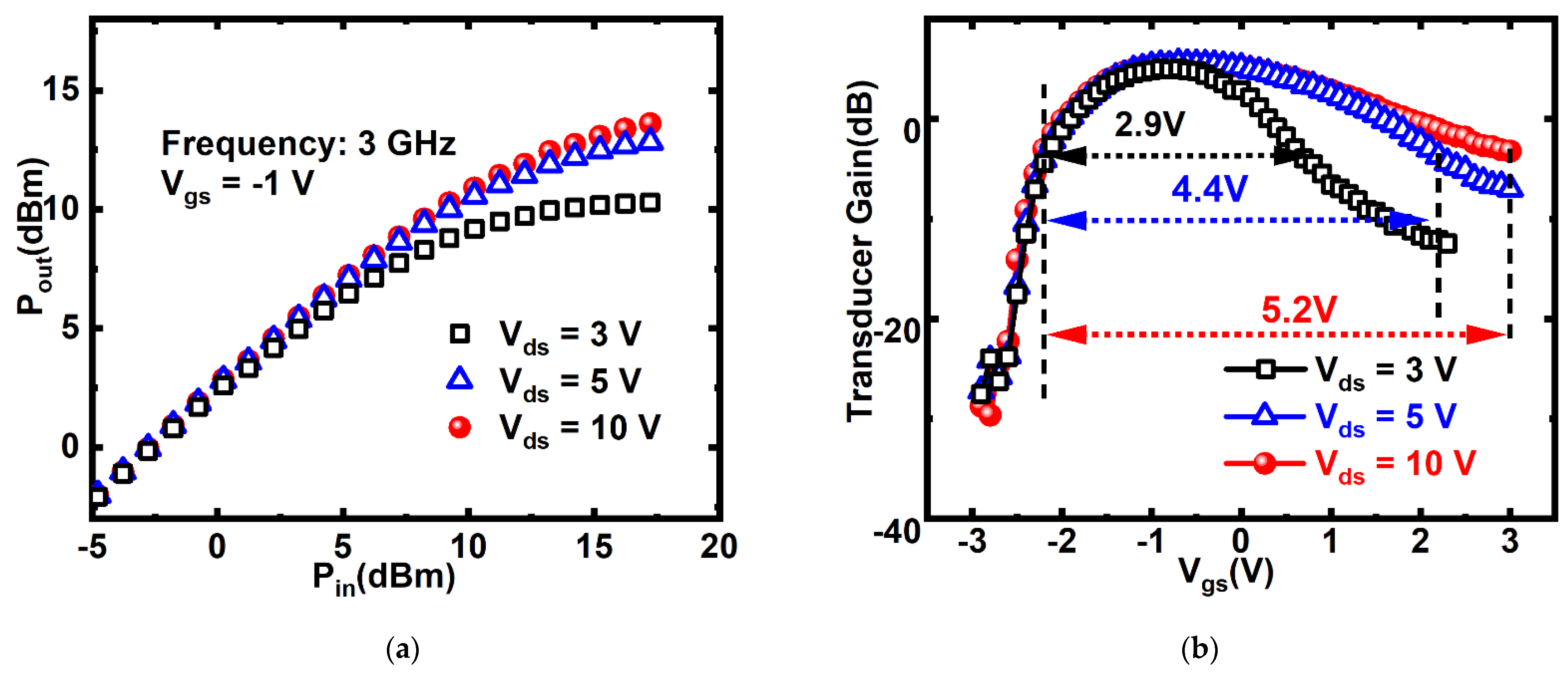Power Compression and Phase Analysis of GaN HEMT for Microwave Receiver Protection
Abstract
:1. Introduction
2. Materials and Methods
3. Results and Discussion
3.1. DC Characteristic
3.2. High Power Compression of the GaN HEMT RP
3.3. Tunable Threshold of the GaN HEMT RP
3.4. Frequency Independent HEMT RP
3.5. Phase Shift Analysis of the HEMT RP
4. Conclusions
Author Contributions
Funding
Conflicts of Interest
References
- Zhang, S.; Liu, L.; Xu, J.; Wang, R.; Zheng, P.; Wang, H.; Li, M.; Kong, X.; Tong, X. Robust GaN-Based LNAs with Active Epitaxial Current Limiters. IEEE Microw. Wirel. Compon. Lett. 2021, 31, 1287–1290. [Google Scholar] [CrossRef]
- Mahmoudidaryan, P.; Medi, A. Codesign of Ka-Band Integrated Limiter and Low Noise Amplifier. IEEE Trans. Microw. Theory Tech. 2016, 64, 2843–2852. [Google Scholar] [CrossRef]
- Deng, S.; Gao, C.; Chen, S.; Sun, J.; Wu, K. Research on Linearity Improvement of Silicon-Based p-i-n Diode Limiters. IEEE Microw. Wirel. Compon. Lett. 2020, 30, 62–65. [Google Scholar] [CrossRef]
- Lim, C.-L. [limiter] Limiters protect ADCs: Without adding harmonics. Microw. RF 2015, 54, 56–60. [Google Scholar]
- Dong, Q.; Ma, X.Y.; Hu, H.Q.; Wang, X.J. 18–40 GHz broadband limiter based on Schottky diode. In Proceedings of the 2015 Asia-Pacific Microwave Conference (APMC), Nanjing, China, 6–9 December 2015; Volume 3, pp. 1–3. [Google Scholar] [CrossRef]
- Fan, G.Q.; Xing, H.Y.; Hu, H.Q. K-Ka band schottky diode limiter. In Proceedings of the 2013 IEEE International Conference on Applied Superconductivity and Electromagnetic Devices, Beijing, China, 25–27 October 2013; pp. 160–162. [Google Scholar] [CrossRef]
- Sun, Y.; Kang, X.; Deng, S.; Zheng, Y.; Wei, K.; Xu, L.; Wu, H.; Liu, X. First Demonstration of L-Band High-Power Limiter with GaN Schottky Barrier Diodes (SBDs) Based on Steep-Mesa Technology. Electronics 2021, 10, 433. [Google Scholar] [CrossRef]
- Wang, Z.; Cao, H.; Zhang, C. Research on the influence of PIN diode on limiter performance in power limiter. In Proceedings of the 2017 7th IEEE International Symposium on Microwave, Antenna, Propagation, and EMC Technologies (MAPE), Xi’an, China, 24–27 October 2017; pp. 220–223. [Google Scholar] [CrossRef]
- Surdi, H.; Ahmad, M.F.; Koeck, F.; Nemanich, R.J.; Goodnick, S.; Thornton, T.J. RF Characterization of Diamond Schottky p-i-n Diodes for Receiver Protector Applications. IEEE Microw. Wirel. Compon. Lett. 2020, 30, 1141–1144. [Google Scholar] [CrossRef]
- Szczepaniak, Z.R.; Arvaniti, A. Analysis of microwave X-band HEMT limiters based on self-limiting effect. In Proceedings of the 12th International Symposium on Electron Devices for Microwave and Optoelectronic Applications, EDMO 2004, Kruger National Park, South Africa, 8–9 November 2004; IEEE: Piscataway, NJ, USA, 2004; pp. 19–22. [Google Scholar]
- Campbell, C.F.; Hitt, J.C.; Wills, K. Wideband GaN FET based limiter MMICs. In Proceedings of the Microwave Integrated Circuits Conference, Amsterdam, The Netherlands, 29–30 October 2012. [Google Scholar]
- Echchakhaoui, K.; Abdelmounim, E.; Bennis, H.; Latrach, M. A Novel Zero Bias Microstrip MESFET Power Limiter. In Proceedings of the ICCWCS 2019: Third International Conference on Computing and Wireless Communication Systems, ICCWCS 2019, Kénitra, Morocco, 24–25 April 2019; European Alliance for Innovation: Ghent, Belgium, 2019; p. 185. [Google Scholar]
- Bera, S.C.; Basak, K.; Jain, V.K.; Singh, R.V.; Garg, V.K. Schottky diode-based microwave limiter with adjustable threshold power level. Microw. Opt. Technol. Lett. 2010, 52, 1671–1673. [Google Scholar] [CrossRef]
- Parra, T.; Gayral, M.; Llopis, O.; Pouysegur, M.; Sautereau, J.; Graffeuil, J. Design of a low phase distortion GaAs FET power limiter. IEEE Trans. Microw. Theory Tech. 1991, 39, 1059–1062. [Google Scholar] [CrossRef]
- Bera, S.C. Microwave Active Devices and Circuits for Communication; Springer: Berlin, Germany, 2019. [Google Scholar]
- Shukla, S.; Kitchen, J. GaN-on-Si switched mode RF power amplifiers for non-constant envelope signals. In Proceedings of the 2017 IEEE Topical Conference on RF/Microwave Power Amplifiers for Radio and Wireless Applications (PAWR), Phoenix, AZ, USA, 15–18 January 2017; pp. 88–91. [Google Scholar] [CrossRef]
- Formicone, G.; Burger, J.; Custer, J.; Keshishian, R.; Veitschegger, W. A study for achieving high power and efficiency based on high bias operation in C- and X-band GaN power amplifiers. In Proceedings of the 2018 IEEE Topical Conference on RF/Microwave Power Amplifiers for Radio and Wireless Applications (PAWR), Anaheim, CA, USA, 14–17 January 2018; pp. 39–42. [Google Scholar] [CrossRef]
- Florian, C.; Gibiino, G.P.; Santarelli, A. Characterization and Modeling of RF GaN Switches Accounting for Trap-Induced Degradation Under Operating Regimes. IEEE Trans. Microw. Theory Tech. 2018, 66, 5491–5500. [Google Scholar] [CrossRef]
- Florian, C.; Gibiino, G.P.; Santarelli, A. Assessment of the Trap-Induced Insertion Loss Degradation of RF GaN Switches Under Operating Regimes. In Proceedings of the 2018 IEEE/MTT-S International Microwave Symposium-IMS, Philadelphia, PA, USA, 10–15 June 2018; pp. 732–735. [Google Scholar] [CrossRef]
- Rudolph, M.; Behtash, R.; Doerner, R.; Hirche, K.; Wurfl, J.; Heinrich, W.; Trankle, G. Analysis of the Survivability of GaN Low-Noise Amplifiers. IEEE Trans. Microw. Theory Tech. 2007, 55, 37–43. [Google Scholar] [CrossRef]
- Rudolph, M.; Dewitz, M.; Liero, A.; Khalil, I.; Chaturvedi, N.; Wipf, C.; Bertenburg, R.M.; Miller, J.; Wurfl, J.; Heinrich, W.; et al. Highly robust X-band LNA with extremely short recovery time. In Proceedings of the 2009 IEEE MTT-S International Microwave Symposium Digest, Boston, MA, USA, 7–12 June 2009; pp. 781–784. [Google Scholar] [CrossRef]
- Kumar, V.; Lu, W.; Schwindt, R.; Kuliev, A.; Simin, G.; Yang, J.; Khan, M.A.; Adesida, I. AlGaN/GaN HEMTs on SiC with fT of over 120 GHz. IEEE Electron Device Lett. 2002, 23, 455–457. [Google Scholar] [CrossRef]
- Jatal, W.; Baumann, U.; Tonisch, K.; Schwierz, F.; Pezoldt, J. High-Frequency Performance of GaN High-Electron Mobility Transistors on 3C-SiC/Si Substrates With Au-Free Ohmic Contacts. IEEE Electron Device Lett. 2015, 36, 123–125. [Google Scholar] [CrossRef]
- Song, W.; Zheng, Z.; Chen, T.; Wei, J.; Yuan, L.; Chen, K.J. RF Linearity Enhancement of GaN-on-Si HEMTs With a Closely Coupled Double-Channel Structure. IEEE Electron Device Lett. 2021, 42, 1116–1119. [Google Scholar] [CrossRef]
- Garg, R.; Natarajan, A.S. A 28-GHz Low-Power Phased-Array Receiver Front-End With 360° RTPS Phase Shift Range. IEEE Trans. Microw. Theory Tech. 2017, 65, 4703–4714. [Google Scholar] [CrossRef]
- Chattopadhyay, M.K.; Tokekar, S. Thermal model for dc characteristics of algan/gan hemts including self-heating effect and non-linear polarization. Microelectron. J. 2008, 39, 1181–1188. [Google Scholar] [CrossRef]
- Yang, L.; Yang, L.-A.; Rong, T.; Li, Y.; Jin, Z.; Hao, Y. Codesign of Ka-Band Integrated GaAs PIN Diodes Limiter and Low Noise Amplifier. IEEE Access 2019, 7, 88275–88281. [Google Scholar] [CrossRef]
- Pantellini, A.; Peroni, M.; Nanni, A.; Bettidi, A. Performance assessment of GaN HEMT technologies for power limiter and switching applications. In Proceedings of the 5th European Microwave Integrated Circuits Conference, Paris, France, 27–28 September 2010; IEEE: Piscataway, NJ, USA, 2010; pp. 45–48. [Google Scholar]
- Tang, Z.; Jiang, Q.; Lu, Y.; Huang, S.; Yang, S.; Tang, X.; Chen, K.J. 600-V Normally Off SiNx/AlGaN/GaN MIS-HEMT With Large Gate Swing and Low Current Collapse. IEEE Electron Device Lett. 2013, 34, 1373–1375. [Google Scholar] [CrossRef]
- Kanamura, M.; Kikkawa, T.; Iwai, T.; Imanishi, K.; Kubo, T.; Joshin, K. An over 100 W n-GaN/n-AlGaN/GaN MIS-HEMT power amplifier for wireless base station applications. In Proceedings of the IEEE InternationalElectron Devices Meeting, Washington, DC, USA, 5 December 2005; pp. 572–575. [Google Scholar] [CrossRef]
- Skyworks, Woburn, MA, and USA. CLA Series: Silicon Limiter Diode Bondable Chips. 2015. Available online: https://www.skyworksinc.com/en/Products/Diodes/CLA4609-000 (accessed on 25 May 2021).
- Seymour, D.J.; Heston, D.D.; Lehmann, R.E.; Zych, D. X-band monolithic GaAs PIN diode variable attenuation limiter. In Proceedings of the IEEE International Digest on Microwave Symposium, Dallas, TX, USA, 8–10 May 1990; IEEE: Piscataway, NJ, USA, 1990; pp. 841–844. [Google Scholar]
- Carroll, J.M. Performance comparison of single and dual stage MMIC limiters. In Proceedings of the 2001 IEEE MTT-S International Microwave Sympsoium Digest (Cat. No.01CH37157), Phoenix, AZ, USA, 20–24 May 2001; Volume 2, pp. 1341–1344. [Google Scholar] [CrossRef]
- Jha, V.; Surdi, H.; Ahmad, M.F.; Koeck, F.; Nemanich, R.J.; Goodnick, S.; Thornton, T.J. Diamond Schottky p-i-n diodes for high power RF receiver protectors. Solid-State Electron. 2021, 186, 108154. [Google Scholar] [CrossRef]
- Gao, T.; Xu, R.; Kong, Y.; Zhou, J.; Kong, C.; Dong, X.; Chen, T. Improved linearity in AlGaN/GaN metal-insulator-semiconductor high electron mobility transistors with nonlinear polarization dielectric. Appl. Phys. Lett. 2015, 106, 243501. [Google Scholar] [CrossRef]
- Naglich, E.J.; Guyette, A.C. Frequency-Selective Limiters Utilizing Contiguous-Channel Double Multiplexer Topology. IEEE Trans. Microw. Theory Tech. 2016, 64, 2871–2882. [Google Scholar] [CrossRef]
- Cui, P.; Lv, Y.; Liu, H.; Cheng, A.; Luan, C.; Zhou, Y.; Lin, Z. Effect of different gate lengths on device linearity in AlGaN/GaN high electron mobility transistors. Phys. E Low-Dimens. Syst. Nanostruct. 2020, 119, 114027. [Google Scholar] [CrossRef]
- Yang, M.; Lv, Y.; Feng, Z.; Lin, W.; Cui, P.; Liu, Y.; Fu, C.; Lin, Z. Study of Gate Width Influence on Extrinsic Transconductance in AlGaN/GaN Heterostructure Field-Effect Transistors With Polarization Coulomb Field Scattering. IEEE Trans. Electron Devices 2016, 63, 3908–3913. [Google Scholar] [CrossRef]
- Kyabaggu, P.B.K.; Haris, N.; Rezazadeh, A.A.; Sinulingga, E.; Alim, M.A.; Zhang, Y. Design and realisation of a pHEMT diode MMIC power limiter using 3D GaAs multilayer CPW technology. In Proceedings of the 2015 European Microwave Conference (EuMC), Paris, France, 7–10 September 2015; pp. 522–525. [Google Scholar] [CrossRef]
- Li, L.; Nomoto, K.; Pan, M.; Li, W.; Hickman, A.; Miller, J.; Lee, K.; Hu, Z.; Bader, S.J.; Lee, S.M.; et al. GaN HEMTs on Si With Regrown Contacts and Cutoff/Maximum Oscillation Frequencies of 250/204 GHz. IEEE Electron Device Lett. 2020, 41, 689–692. [Google Scholar] [CrossRef]
- Zhang, X.W.; Jia, K.J.; Wang, Y.G.; Feng, Z.H.; Zhao, Z.P. AlNGaN HEMT T- gate optimal design. Appl. Mech. Mater. 2013, 347, 1790–1792. [Google Scholar] [CrossRef]
- Chung, J.W.; Hoke, W.E.; Chumbes, E.M.; Palacios, T. AlGaN/GaN HEMT With 300-GHz fmax. IEEE Electron Device Lett. 2010, 31, 195–197. [Google Scholar] [CrossRef]
- Alim, M.A.; Rezazadeh, A.A.; Gaquiere, C. Temperature Effect on DC and Equivalent Circuit Parameters of 0.15-μm Gate Length GaN/SiC HEMT for Microwave Applications. IEEE Trans. Microw. Theory Tech. 2016, 64, 3483–3491. [Google Scholar] [CrossRef]
- Berroth, M.; Bosch, R. Broad-band determination of the FET small-signal equivalent circuit. IEEE Trans. Microw. Theory Tech. 1990, 38, 891–895. [Google Scholar] [CrossRef] [Green Version]






Publisher’s Note: MDPI stays neutral with regard to jurisdictional claims in published maps and institutional affiliations. |
© 2022 by the authors. Licensee MDPI, Basel, Switzerland. This article is an open access article distributed under the terms and conditions of the Creative Commons Attribution (CC BY) license (https://creativecommons.org/licenses/by/4.0/).
Share and Cite
Song, W.; Guo, H.; Gu, Y.; Zhou, J.; Sui, J.; Chen, B.; Huang, W.; Zou, X. Power Compression and Phase Analysis of GaN HEMT for Microwave Receiver Protection. Electronics 2022, 11, 1958. https://doi.org/10.3390/electronics11131958
Song W, Guo H, Gu Y, Zhou J, Sui J, Chen B, Huang W, Zou X. Power Compression and Phase Analysis of GaN HEMT for Microwave Receiver Protection. Electronics. 2022; 11(13):1958. https://doi.org/10.3390/electronics11131958
Chicago/Turabian StyleSong, Wenhan, Haowen Guo, Yitian Gu, Junmin Zhou, Jin Sui, Baile Chen, Wei Huang, and Xinbo Zou. 2022. "Power Compression and Phase Analysis of GaN HEMT for Microwave Receiver Protection" Electronics 11, no. 13: 1958. https://doi.org/10.3390/electronics11131958





